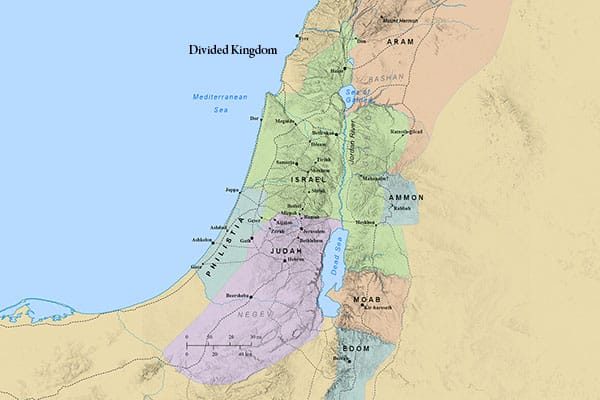The Kingdom of Israel Divides
931 BC
Carousel of images for this Bible Exhibit
Listen to this Bible Exhibit
After King Solomon’s death, his son Rehoboam became the new king. The people of Israel came to him at Shechem, asking for some relief from the heavy taxes and labor imposed on them during Solomon’s reign.
Rehoboam initially sought counsel from his father’s advisors, who suggested he listen to the people’s requests and treat them kindly. However, Rehoboam also consulted his younger advisors, who urged him to be even harsher and demand even greater tribute from the people. He foolishly chose to follow the advice of his adolescent friends and told the northern tribes that he would not ease their tax burden. This led to a rebellion, and the ten northern tribes divided and formed their own kingdom, keeping the name Israel and appointing Jeroboam as their new king. Jeroboam, a former officer of Solomon, had returned from exile in Egypt to help lead this revolt. Meanwhile, Rehoboam remained king of the southern tribes of Judah and Benjamin 1 Kings 12:1-24.
The boundary between Israel and Judah ran south of Jericho, Bethel, and Joppa. The line often changed, however, being moved northward or southward depending on the relative strength of the two nations. The capital of Israel was first at the historic city of Shechem, then at Tirzah. Omri, the founder of the third dynasty, chose Samaria as the site of his permanent capital, and it remained there until the Assyrians destroyed the kingdom. Religious sanctuaries were maintained at Dan in northern Israel and at Bethel near the southern border. The Southern Kingdom of Judah included the tribe of Judah and Benjamin, with kings reigning from the line of David.
The division of the kingdom was seen as a punishment from God for Solomon’s idolatry and disobedience. The North had nine dynasties and 19 kings, and their reigns were generally short. In the South, the dynasty of David continued to rule through 20 kings, and their reigns tended to be longer due to some faithful obedience to God. However, throughout its history, the Northern Kingdom would continue to be plagued by corruption and idolatry, eventually falling to the Assyrians in 722 B.C. The Southern Kingdom of Judah would continue for a few hundred years until the Babylonians conquered it under King Nebuchadnezzar, who destroyed Jerusalem in 586 B.C.








